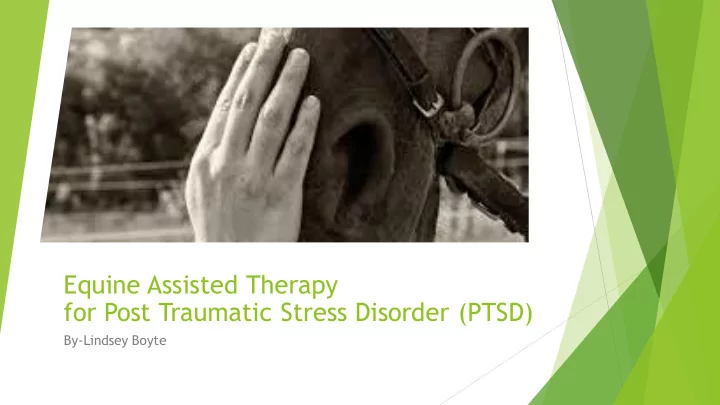

Equine Assisted Therapy for Post Traumatic Stress Disorder (PTSD) By-Lindsey Boyte
What is PTSD Posttraumatic stress disorder ( PTSD ) is a mental disorder that can develop after a person is exposed to a traumatic event. Someone with PTSD may experience feeling stressed or frightened even when they are not in danger. Flashbacks Nightmares Rapid heart beat Avoidance of a place, thought, or emotion Anger problems Easily startled
What is Equine Assisted Therapy? In Equine Assisted Therapy (EAT) “horses are used in mounted or unmounted exercises outside of a clinical setting to guide clients through a psychological journey of healing and self- understanding” (Kitchener, 2018). https://youtu.be/Z7EedCwJ4ww
What's the Hype? Equine assisted therapy can increase awareness and mindfulness. Equine assisted therapy can improve social skills. Equine assisted therapy can help orient a person to person, place, and time. Equine assisted therapy can build confidence. Equine assisted therapy requires no use of Phamaceuticals!!!
How will this Intervention help with PTSD? Results of PTSD that can be helped by Equine assisted therapy: Decreased confidence. Flashbacks (unoriented to person place or time). Social problems (awareness and mindfulness).
No certification required legally but it is recommended The therapist should have a Staff great knowledge of horses. Requirements The therapist and staff members should also know what to do in times of danger.
This intervention will be 1:1 Duration and 2 times a week Group Size 1-hour long sessions 6 weeks total
Horses temperament should be tested The area should have no distractions Allergies must be taken into consideration working with animals Close toed shoes are required. Safety First!! Participants will always be required to wear a helmet. Clothing needs to be appropriate for moving around. No reflective jewelry or clothing items that could stun the horse.
Large open space Grooming supplies (brushes, soap, bows, other accessories) Riding supplies (Saddles. Materials Blankets. Reins, Belts if needed to help the Needed participant sit up, helmets) Platform used to mount the horse Horse treats
How we will Measure Progress Before and after the 6-week intervention the client will be giving these questions to answer Do you feel aware of yourself and your motions? Do you feel you have confidence in yourself? Do you feel you are mindful or others around you? Do you feel you socialize effectively with those around you? Do you feel you are insightful, or have a strong intuition? After each session, the client will meet with the therapist for 30 minutes to discuss the session.
My Intervention Part 1: Grooming & Intro What the client will do in this section: Groom the horse Pet the horse Talk with the horse Things the client will accomplish in this section: Bond with their horse Become aware the horse's movements and reactions to touch
My Intervention Part 2: Games and Movements What the client will What the client will do in accomplish in this this section: section: • They will have the • Gain awareness of their horse go forwards, horses movements backwards, turn to the • Gain confidence as they left, turn to the right, move through the steps and stop.
Lead Observe/learn Lead with guidance independently (unmount (unmounted) (unmounted) ed) Part 2- The Mounted and leading the Learn to mount the Mounted and horse being horse with help from the horse (unmounted) led by the therapist steps therapist Mounted and leading Mounted leading independently with independently with therapist just walking therapist just observing along
The Results Increased mindfulness Increased confidence Increased insight Increased awareness of verbal and nonverbal behaviors Increase in orientation to person, place, and time Understanding of equine assisted therapy
Sources Acri, M., Hoagwood, K., Morrissey, M., & Zhang, S. (2016). Equine-assisted activities and therapies: enhancing the social worker’s armamentarium. Social Work Education, 35(5), 603 – 612. https://doi-org.proxy195.nclive.org/10.1080/02615479.2016.1173669 Earles, J. L., Vernon, L. L., & Yetz, J. P. (2015). Equine-assisted therapy for anxiety and posttraumatic stress symptoms. Journal Of Traumatic Stress, 28(2), 149 – 152. https://doi- org.proxy195.nclive.org/10.1002/jts.21990 KITCHENER, N. (2018). Helping Hooves Treating veterans with equine therapy: is it healing invisible wounds? Horse-Canada.Com, 17(5), 38 – 41. Retrieved from https://login.proxy195.nclive.org/login?url=https://search.ebscohost.com/login.aspx?direct=true& db=s3h&AN=131535467&site=ehost-live MacLean, B. (2011). Guest Editorial. Equine-assisted therapy. Journal of Rehabilitation Research & Development, 48(7), ix – xii. Retrieved from https://login.proxy195.nclive.org/login?url=https://search.ebscohost.com/login.aspx?direct=true& db=s3h&AN=70401157&site=ehost-live&scope=site Rigby, B. R., & Grandjean, P. W. (2016). The Efficacy of Equine-Assisted Activities and Therapies on Improving Physical Function. Journal Of Alternative And Complementary Medicine (New York, .), 22(1), 9 – 24. https://doi-org.proxy195.nclive.org/10.1089/acm.2015.0171 N.Y
Questions?
Recommend
More recommend